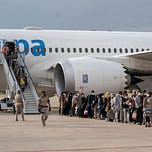Six days ago, as she prepared her airlifted exit from Kabul, CNN reporter Clarissa Ward declared that the United States’ effort to evacuate thousands of Afghans was doomed to failure. “I'm sitting here for 12 hours in the airport, 8 hours on the airfield and I haven't seen a single US plane take off,” she reported. “How on Earth are you going to evacuate 50,000 people in the next two weeks? It just, it can’t happen.”
Ward seemed to speak for most journalists who lined up for days to condemn President Joe Biden and to predict a perilous future for the Afghanistan capitol. (Talk of “mass murders” and U.S. embassy employees being taken hostage were in the media mix.) Wildly eager to portray the U.S. troop withdrawal as a “humiliating” and “disastrous” “fiasco,” the media were sure the story was going to get much worse.
And they were wrong.
“In fact, it didn’t take 2 weeks to evacuate 50,000. It took 10 days,” Sen. Chris Murphy (D-CT) tweeted in response to Ward. “Lots of work still to do, but it might be time for a bit of a reassessment by the media of this operation given the actual results.”
Don’t hold your breath waiting for journalists to acknowledge that their assessments of Kabul have been badly undercut by the stunning evacuation success.
For the first 10 days of the refugee crisis, the media obsessed over "optics" and how they were "disaster" for Biden. Suddenly though, the press shows little interest dwelling on the optics of successfully extricating nearly 100,000 people without a single U.S. casualty. Instead, the press remains married to its narrative.
That early media emphasis on optics was all consuming. “President Biden's Reassurances on Afghanistan Contradict Chaotic Images on the Ground, Capping Week of Bad Optics For His Administration,” CNN announced.
According to the New York Times, the optics were so bad they threatened to doom Biden’s entire presidency. “The chaotic endgame of the American withdrawal has undercut some of the most fundamental premises of President Biden’s presidency,” the paper claimed, in a page-one piece that implied the Democrat was incompetent, void of empathy, and “struggling to assert command over world events.”
Those turned out to be hollow claims, given the U.S.’s commitment to evacuating so many people this month, and nearly 20,000 on Tuesday alone.
Over the weekend, the Times published a sprawling overview of the U.S. troop withdrawal. Written by six staffers, it was relentlessly negative in its portrayal. Headline: “This Is How the U.S.'s Afghanistan Exit Plan Unraveled.”
In light of the miraculous evacuation success, when is the newspaper going to assign six reporters to produce a tick tock retelling of how the Biden team pulled off what many insisted was impossible? Or is good news no news when it comes to Biden?
Eventually addressing the historic evacuation campaign, the Times seemed to downplay the success, framing the airlift as a “public relations” tool being used by a White House “eager to shift the narrative.”
Buried in the article’s final paragraph was the revelation that during the collapse of Saigon in 1975, the U.S. evacuated just 7,000 people, as the South Vietnamese capitol famously fell. That’s telling because at the beginning of the Kabul story 13 days ago, news outlets were obsessed with making the historical connection with Saigon at the end of the Vietnam War. Turns out the U.S. has evacuated 100,000 more people from Kabul than the U.S. did in 1975. Suddenly, those Saigon comparisons don’t make sense.
Downplaying the evacuation became the media norm this week. A recent Times headline declared “Chaos at Airport as Taliban Work on Creating State.” It wasn’t until the ninth paragraph that readers learned 8,000 people had been evacuated the day before.
A Washington Post piece held off until the 13th paragraph to spell out the feel-good news about 21,000 evacuations on Monday. This, after emphasizing the Biden administration had “stoked a new round of outrage,” “there was looming uncertainty,” “intensifying anger,” and that “West Wing officials scrambled,” but could do “little to quell the frustration.”
On Tuesday, Politico went all in with a doomsday account of Kabul, accusing the White House of being “increasingly disconnected from reality” and not able to curb sprawling violence. Barely mentioned was the evacuation triumph.
The next day, even as exit numbers hit the 100,000 plateau, Politico insisted the Beltway media still viewed Afghanistan as a disaster: “The view in the dominant media, where highbrow foreign policy coverage is deeply influenced by the so-called Blob’s view of the world, is that Biden’s evacuation is an unmitigated disaster, that his every statement is at odds with the reality on the ground and that the botched pullout will have long-term political damage in 2022 and 2024.”
Politico also implied, without evidence, that the administration was cooking the books on the evacuation numbers. That’s how badly the press doesn’t want to acknowledge the success story that has unfolded.
CNN published yet another doomsday update about the airport on Monday: “Kabul's Airport is the Epicenter of a Desperate and Deadly Scramble to Escape the Taliban.” The article stressed the situation was “increasingly desperate” and “becoming increasingly perilous.” The report made just passing reference to the tens of thousands of people being flown out of Kabul. And the video report that accompanied the online article, featuring CNN’s Sam Kiley, did not depict an “increasingly perilous” situation. Instead, it showed orderly lines of Afghans waiting to board U.S. planes.
Two days later, Kiley confirmed to CNN viewers, “We arrived midafternoon on a Qatari flight and I was pleased and relieved to see quite large, well-ordered queues of people already being loaded onto aircraft from around the world.”
That’s just not the storyline the network wants to emphasize.
⚖️ GOOD STUFF:
From Law and Crime’s “‘This Case Was Never About Fraud’: Federal Judge Refers ‘Kraken’ Attorneys, Including Lin Wood and Sidney Powell, for ‘Possible Suspension or Disbarment’”
“This lawsuit represents a historic and profound abuse of the judicial process,” [U.S. District Judge Linda] Parker wrote in her opinion and order. “It is one thing to take on the charge of vindicating rights associated with an allegedly fraudulent election. It is another to take on the charge of deceiving a federal court and the American people into believing that rights were infringed, without regard to whether any laws or rights were in fact violated. This is what happened here.”
“Plaintiffs ask this court to ignore the orderly statutory scheme established to challenge elections and to ignore the will of millions of voters,” Parker wrote. “This, the Court cannot, and will not, do.”
“The People have spoken,” she added.
🎸 FUN STUFF — BECAUSE WE ALL NEED A BREAK
The Killers, “In Another Life”
Isolation, desperation, and ruminations are at the heart of The Killers’ new album, which focuses on the small Utah town where lead singer Brandon Flowers grew up in. “In Another Life” we hear the voices of regret, wondering if they should have left a long time ago.
The topic is heavy and a bit dark, but the song ignites like a firecracker, as The Killers deliver a melodic, hard-charging rock ode to our shifting and blurry American dream.
(And just FYI, the song begins with a taped spoken intro.)
When will I make it home?
When I damn well feel like driving
Down these empty streets
That burn though our birthright













